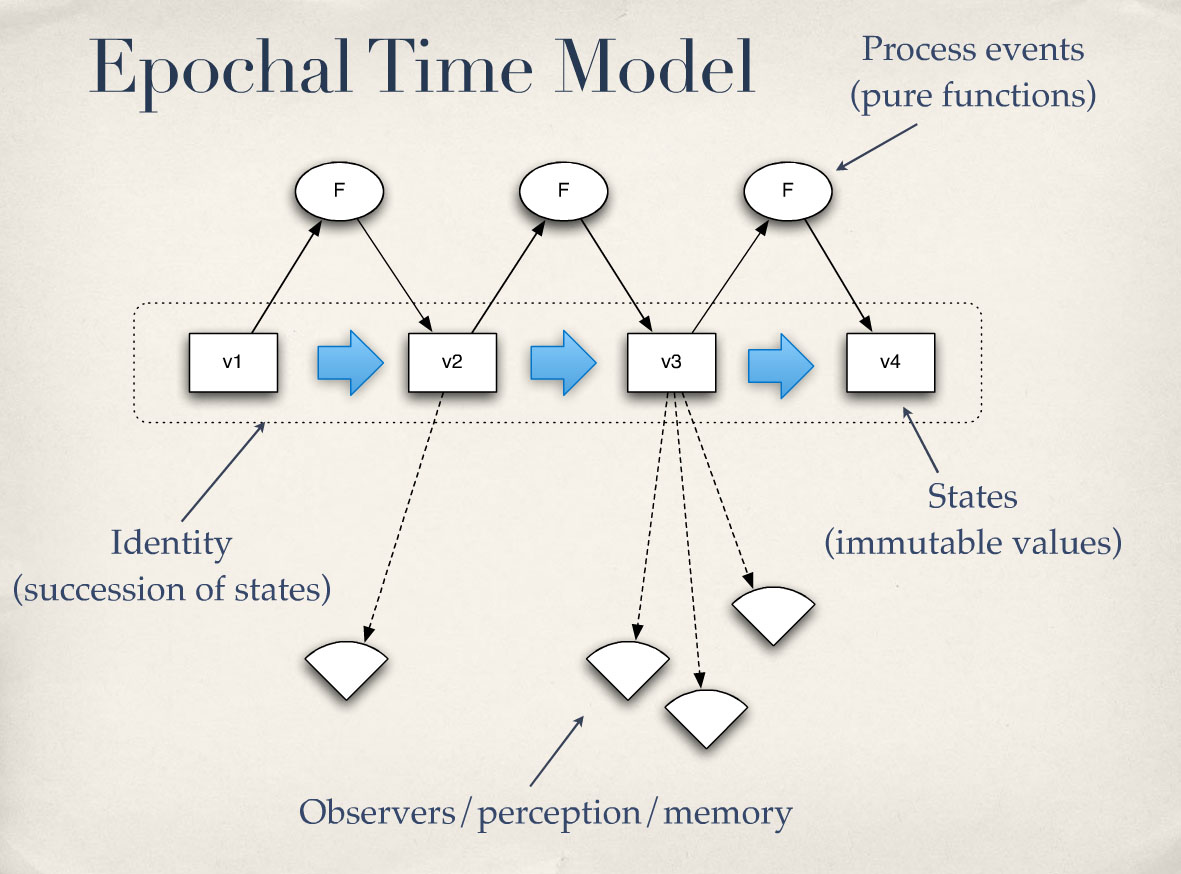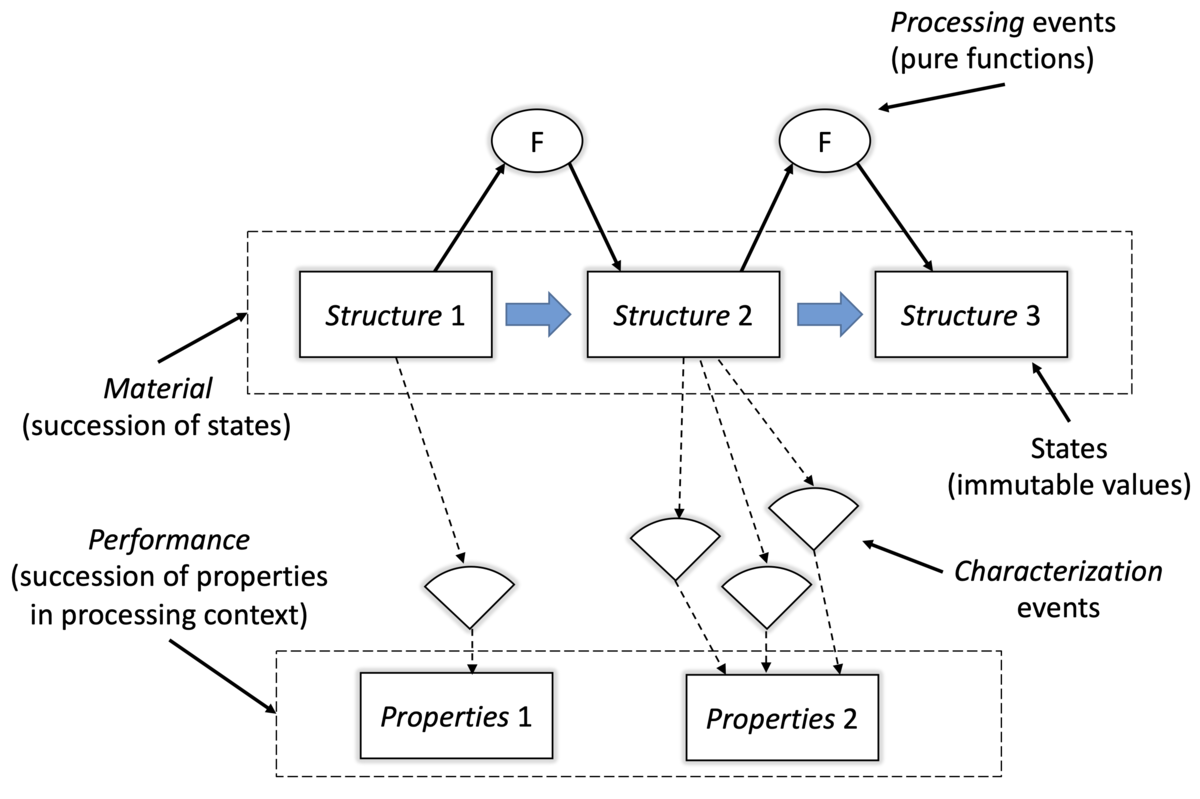The Materials Paradigm and Epochal Time
The materials paradigm1 may be represented in the form of a tetrahedron2, illustrating a set of material concerns and how they are interrelated.

The materials science tetrahedron, which illustrates how a material's properties, processing, performance, and structure are interrelated (source).
What is a “material”? There is no label for it in the diagram above. And what is the nature of the relationships among properties, processing, performance, structure, and characterization in the diagram above? From the diagram, each “edge” connecting “nodes” is indistinct – it seems that everything connects to everything else in the same way, except for characterization, which is a thing that just floats in the middle, geometrically equidistant from every node in the fully connected graph.
In Process and Reality, Whitehead elaborates on an epochal theory of time3, for which Hickey produced a useful diagram4 as part of his work to apply this model to programming language design. I believe this diagram can be usefully related to that of the materials paradigm tetrahedron.

Epochal time model, from Rich Hickey's "Are We There Yet" talk (transcript).
Consider a given material structure as a value, an unchanging thing, as opposed to a variable. Consider that this unchanging thing, this structure-as-value, may be observed/perceived/remembered in a manner that does not change it, that does not change the structure – this is characterization.
Now, consider an event that, when it “happens” to a structure, when it applies to a structure, results in a different structure, i.e. a different value is observed after the event – this is processing. Processing is a function that takes one value to another value, one structure to another structure.
What, then, is a “material”? A material is a post hoc composition of structure values, an identity assigned to a succession of values related by successive processing events. A structure-as-value is associated with a material-as-identity, and a value assigned to an identity may be termed a “state” of that identity. The conceptually synthesized identity, the material, “has” states, and through characterization, through observation/perception, a state “has” properties. A property is an output value of a characterization process that takes a structure as an input value.
What is perceived from a value may be termed a property of the value, and if the input value is associated with an identity, the perception may be thought of as a property of a state of the identity, or alternatively as a property of the identity at a given moment in time, i.e. at a given state. Thus, a “material property” is a characterization of one or more distinct structures identified as a material via an epochal succession of processing events. When a material “changes” via processing, its properties may “change” as well because the observed properties depend on structures, on values, on “states” of a “material”, not on the post hoc material-as-identity.
In this model, time is not a continuously running clock. Time happens in discrete steps, epochs, one-to-one with events that represent the processing of values. A “state” is a snapshot, a material-as-identity’s structure-as-value at a given “moment”5 “in time”. This state is customarily extended by idempotent characterization of that structure’s properties-as-values.
Finally, what is material performance in terms of the epochal time model? A material’s performance is determined from the characterized properties of that material’s structural state space in a given environmental context of process control that dictates state transitions. That is, material performance is an identity assigned to a succession of characterized-properties values that are sourced in turn from the succession of structures reached by a materials-as-identity in a processing context. See the diagram below.
 An epochal-time model of the materials paradigm.
An epochal-time model of the materials paradigm.
Just as the epochal time model was productively applied to the design and implementation of the Clojure programming language, I hope that this model as mapped to the elements of the materials-paradigm tetrahedron above can be productively applied to the design and implementation of materials research management systems.
References
par·a·digm (noun) - “a philosophical and theoretical framework of a scientific school or discipline within which theories, laws, and generalizations and the experiments performed in support of them are formulated”. From https://www.merriam-webster.com/dictionary/paradigm, accessed 2020-11-22. ↩︎
https://en.wikipedia.org/wiki/Materials_science, accessed 2020-11-22. ↩︎
Alfred North Whitehead, Process and Reality: An Essay in Cosmology (1929). Cambridge University Press. ↩︎
Rich Hickey. “Are We There Yet?”, presented at the JVM Languages Summit, 2009 (transcript). ↩︎
Some evidence that the notion of a moment indicates epochal movement/processing: “contraction of movimentum, from movere “to move” (from Proto-Indo-European root meue-, ’to push away’).” From https://www.etymonline.com/word/moment, accessed 2020-11-22. ↩︎